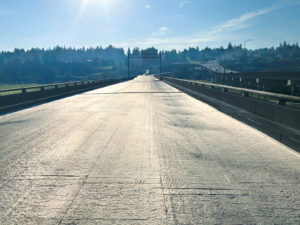
The wet weather in Washington state is a bane to the region’s travel infrastructure, plaguing the pavement with perpetual problems.
The westbound 3-mile (5-km) stretch across the US 2/I-5 interchange from Bickford Avenue in Everett, Wash., was in particular need of repair. A valuable pipeline for business and commuting, the bridged area transported an average of 22,000 vehicles daily. Yet, potholes, ruts and uneven surfacing resulted in pooling water that not only jeopardized driver safety, but also threatened to destroy the concrete decking.
Having completed the eastbound paving a few years prior, the Washington State Department of Transportation (WSDOT) now addressed its counterpart. The westbound project would be more complex, requiring 536,000 square feet (50,000 m2) of geosynthetics, one of the largest quantities used by WSDOT for a single waterproofing project. All work would be done overnight and on weekends to minimize the effects on transportation flow.
The primary contractor had managed several paving projects for the state, partnering with a subcontractor noted for geosynthetics expertise to do the underlying waterproofing geocomposite. The subcontractor chose a high-strength, peel-and-stick waterproofing geocomposite comprised of fully modified, styrene-butadiene-styrene (SBS) asphalt mastic on a nonwoven polyester geotextile.
The teams broke up the existing asphalt with excavators, cleaning/blowing off the deck and tearing off the old geomembrane. They then sprayed asphalt primer evenly on the area, before rolling out the 48-inch (122-cm) geocomposite across the center. They could avoid applying hot mastic in the seams by doing a 4-inch (10-cm) overlap that sealed out moisture prior to hot mix asphalt overlay. Since most work was done in low visibility, the geocomposite’s uniformity and ease of use were essential.
Because of its size and complexity, the US 2/I-5 interchange project will serve as a model for future WSDOT pavement preservation initiatives.
 TEXTILES.ORG
TEXTILES.ORG


